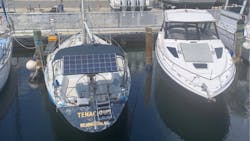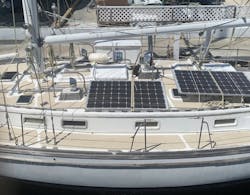Photovoltaics became ubiquitous while we weren’t looking!
Solar PV is more than the commonplace residential and commercial rooftop arrays that continue to multiply, especially in states like California where, according to Forbes Home, more than 38% of homes are now solar-powered; in Nevada, where more than 42% of the homes have PV; and Arizona and Utah, each of which boast 18% of its homes with solar PV.
Although rooftop PV arrays – including PV roof tiles and building-integrated PVs and ground-mounted arrays are the most common for primary or ancillary electric power for residential and commercial buildings, there are numerous other applications, both indoor and outdoor, that we may not even notice.
For example, how many of us can even remember when and where we got our first PV calculator, capable of being powered by ambient indoor lighting? Now they are common giveaways at trade shows.
In my own experience, I’ve had literally dozens of PV-powered devices that I took for granted, ranging from the PV/battery backup fence charger that protected our horse pasture in Pennsylvania in the late 1990s, to my first hybrid car (a Prius) that had PV on the roof to power air circulation when the car was parked in the sun, to the PV-powered/hand-crank backup emergency radio that we now rely on in Florida, especially during hurricane season.
These extremely small PV systems, often referred to as pico PV can, in addition to radios, power such devices as flashlights and lanterns, MP3 players, watches, phone chargers, and even small fans. Then there is PV-powered landscape and pathway lighting, street lighting, traffic calming and information signage (yes, I know I’m speeding! thanks!), bus stop lighting, and the PV-powered E-bikes and scooters that are rampant here in South Florida.
Of course, electric vehicle charging is another common application for PV, and not just cars and trucks (although solar-powered EV charging stations are prevalent in Europe and their numbers are increasing in the U.S.). Solar cells have been part of every U.S. spacecraft since the launch of the first Vanguard 1 satellite in 1958. Solar PV panels on boats are also a common sight here in South Florida.
During a recent stay in Key Largo, I had the opportunity to do a boat trip to Molasses Reef, a coral reef located within the Florida Keys National Marine Sanctuary, approximately 5.5 nautical miles offshore. During the ride out to open water, I counted nearly half of the sailboats moored in the canals with solar panels installed.
Incidentally, Molasses Reef, which is a designated “Sanctuary Preservation Area”, is well-known for its exciting diving and snorkeling, with more than 600 possible species of marine life. It shouldn’t be a surprise that sailors living there would promote sustainability by using renewable energy on their boats. When they’re under sail and charging their batteries with PV, there are no carbon emissions.
And by the way, none of this is being mandated by any government at any level. It's just well-intentioned citizens trying to make a difference.
Which begs the question: How can the rest of us use more renewable energy, even in little things, to reduce our carbon footprint?

